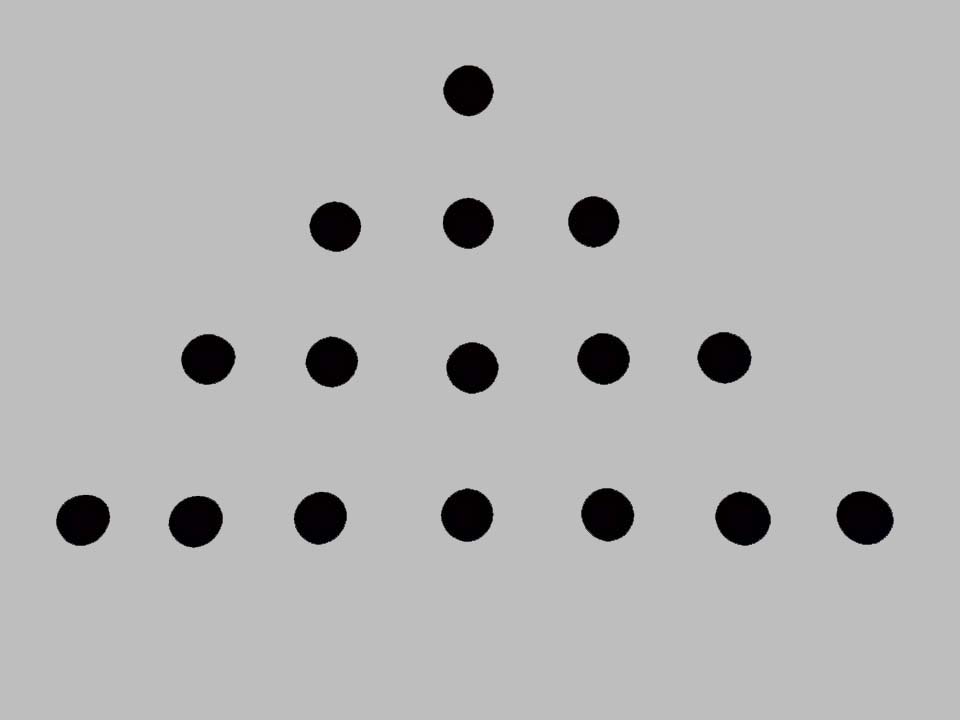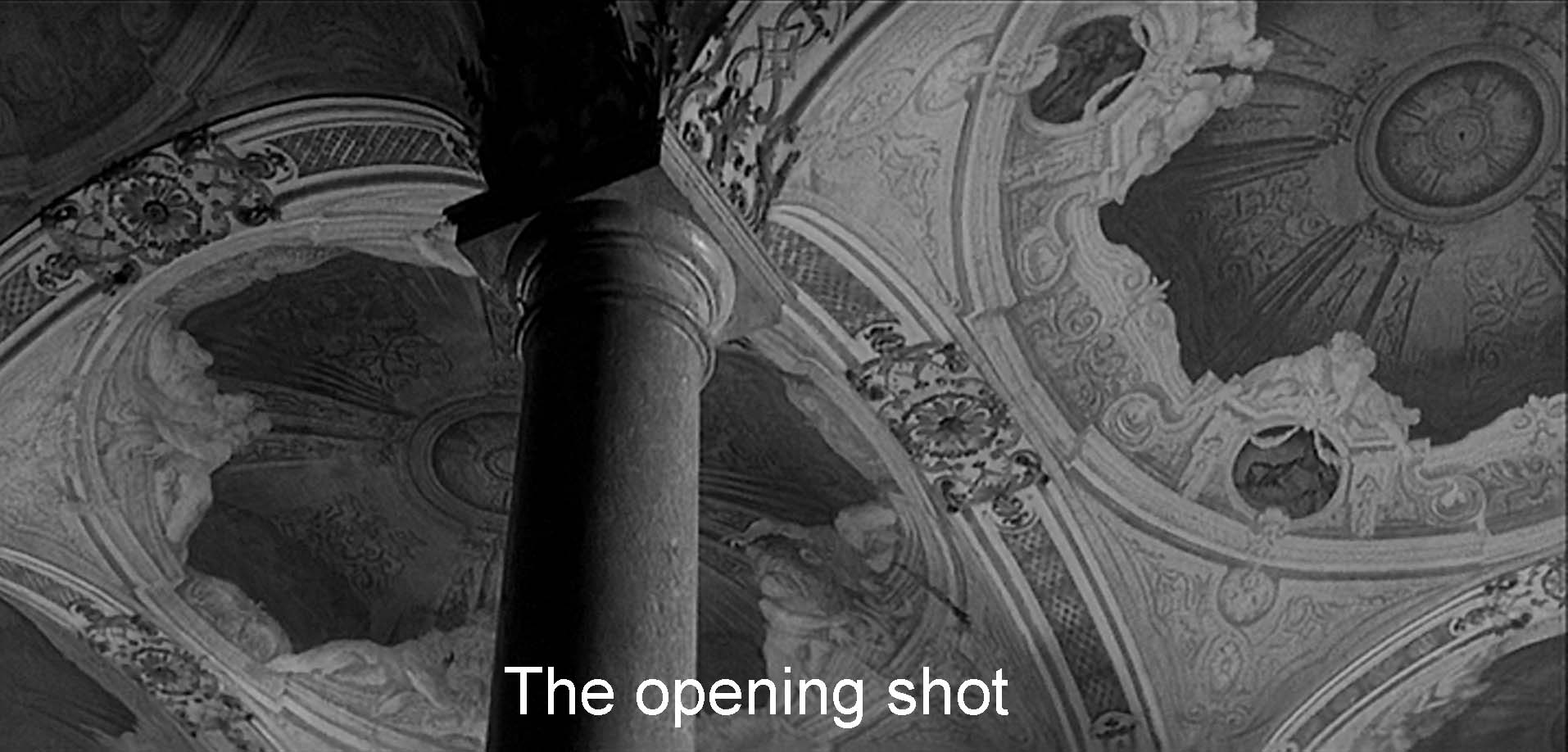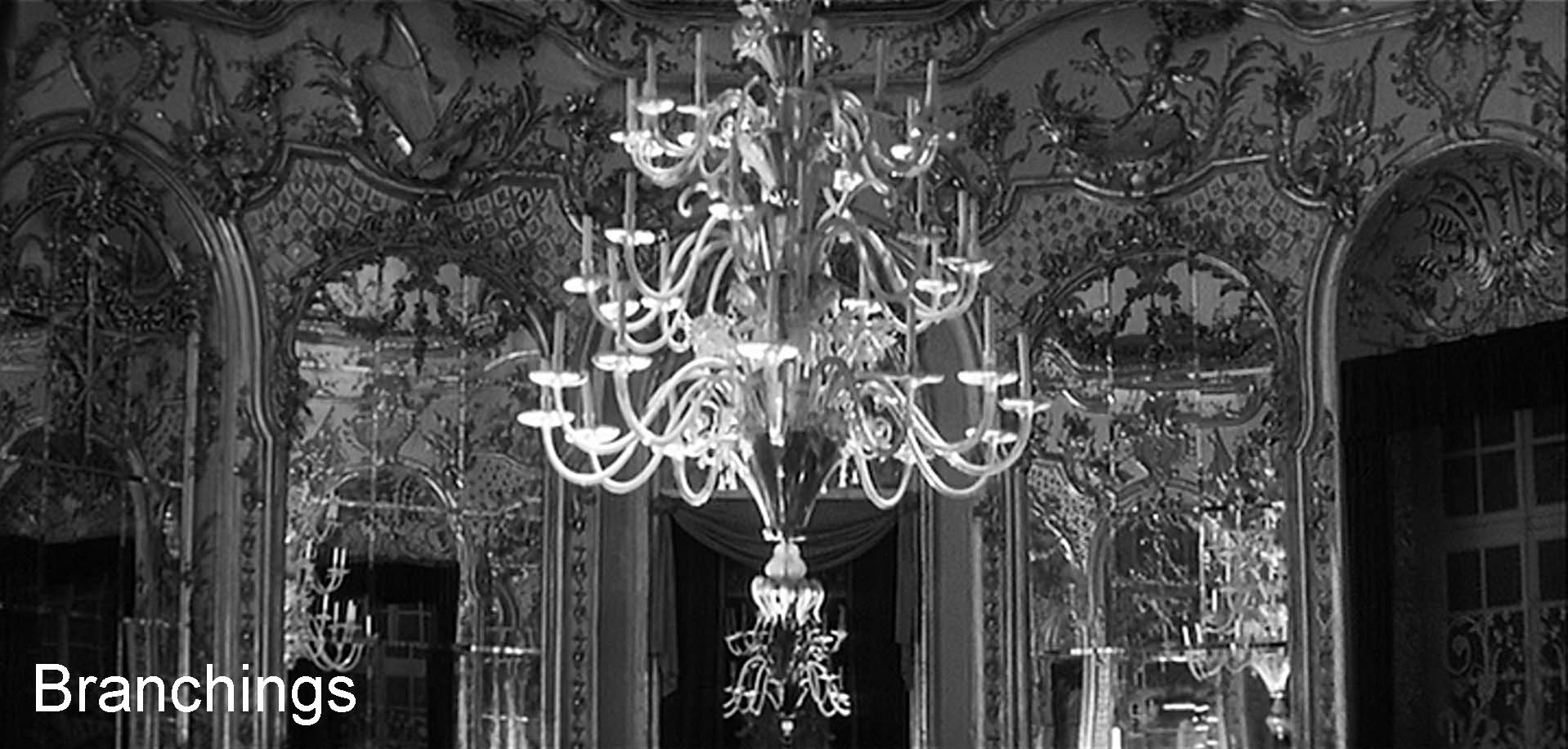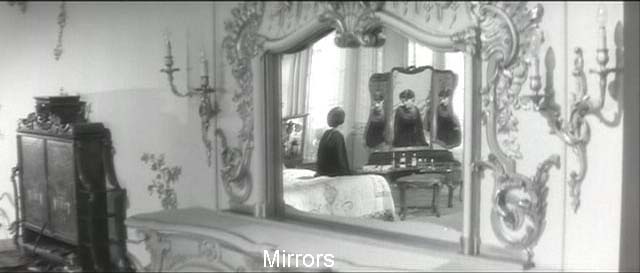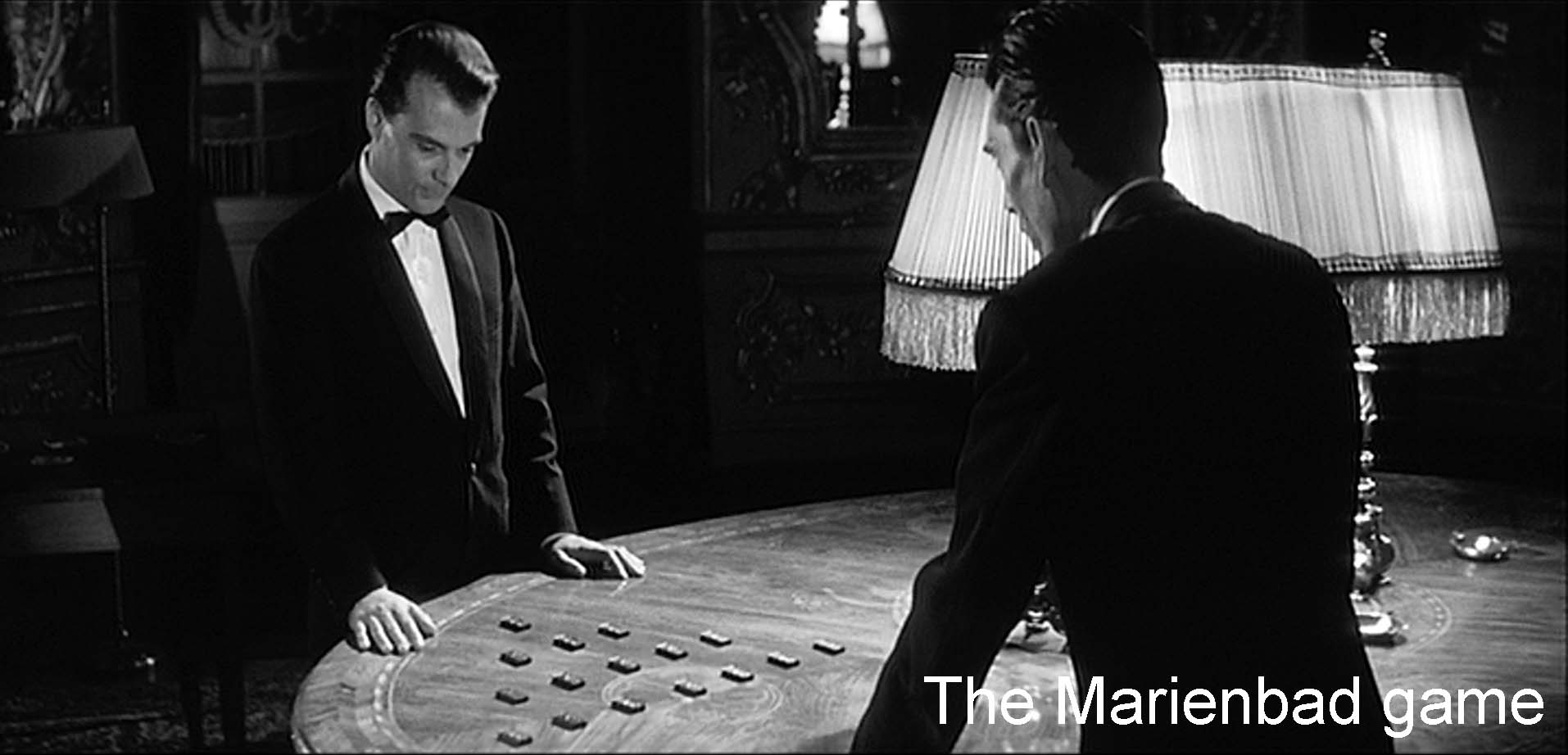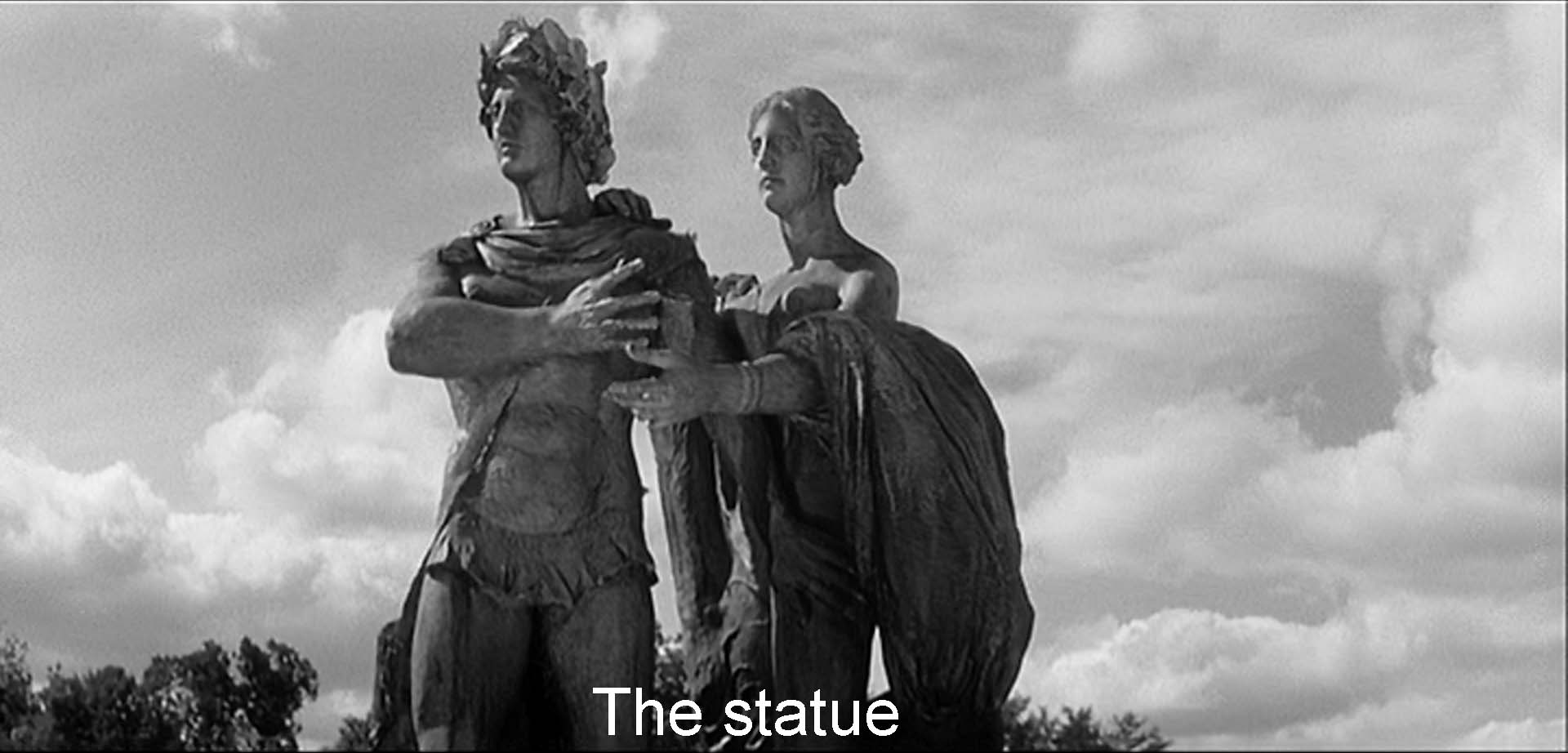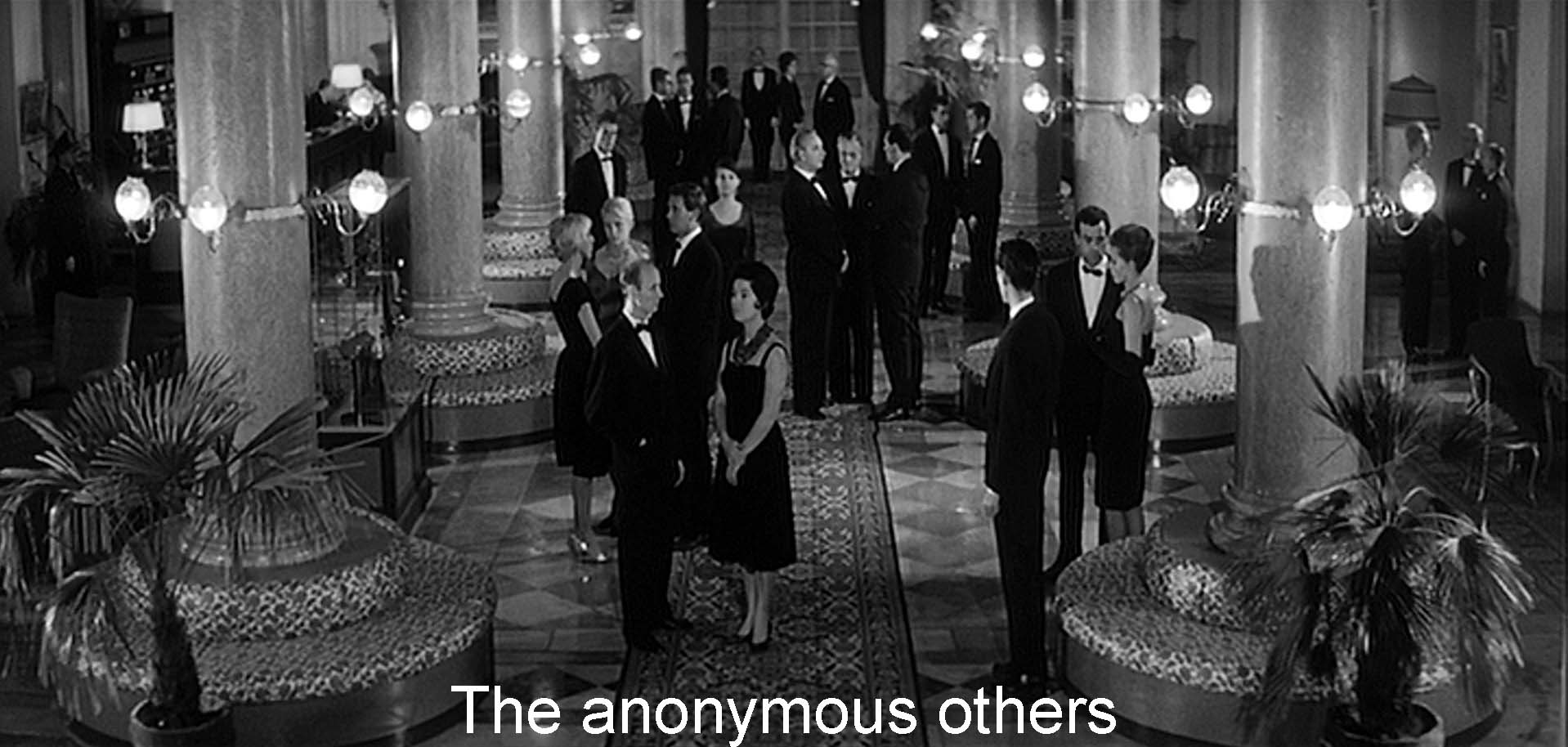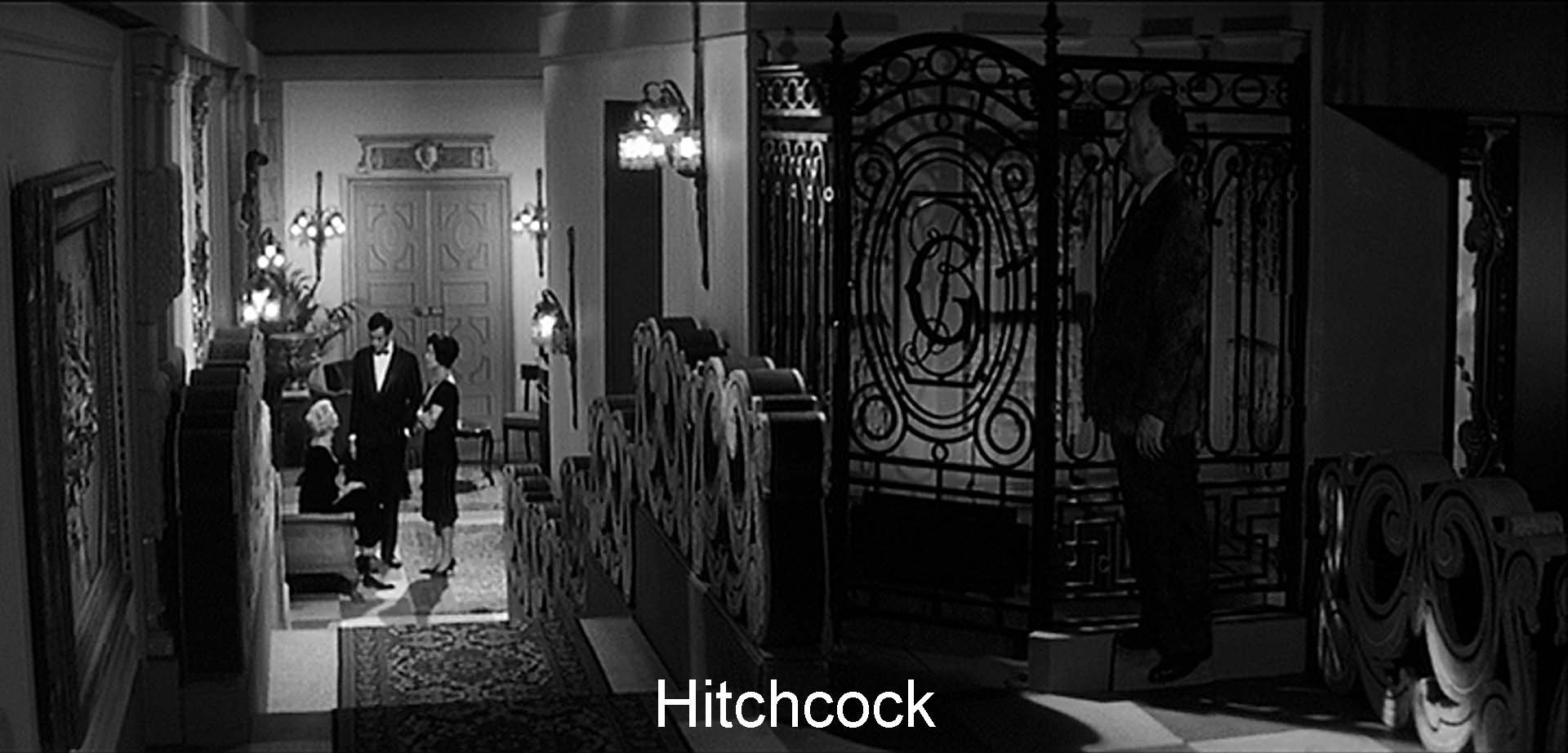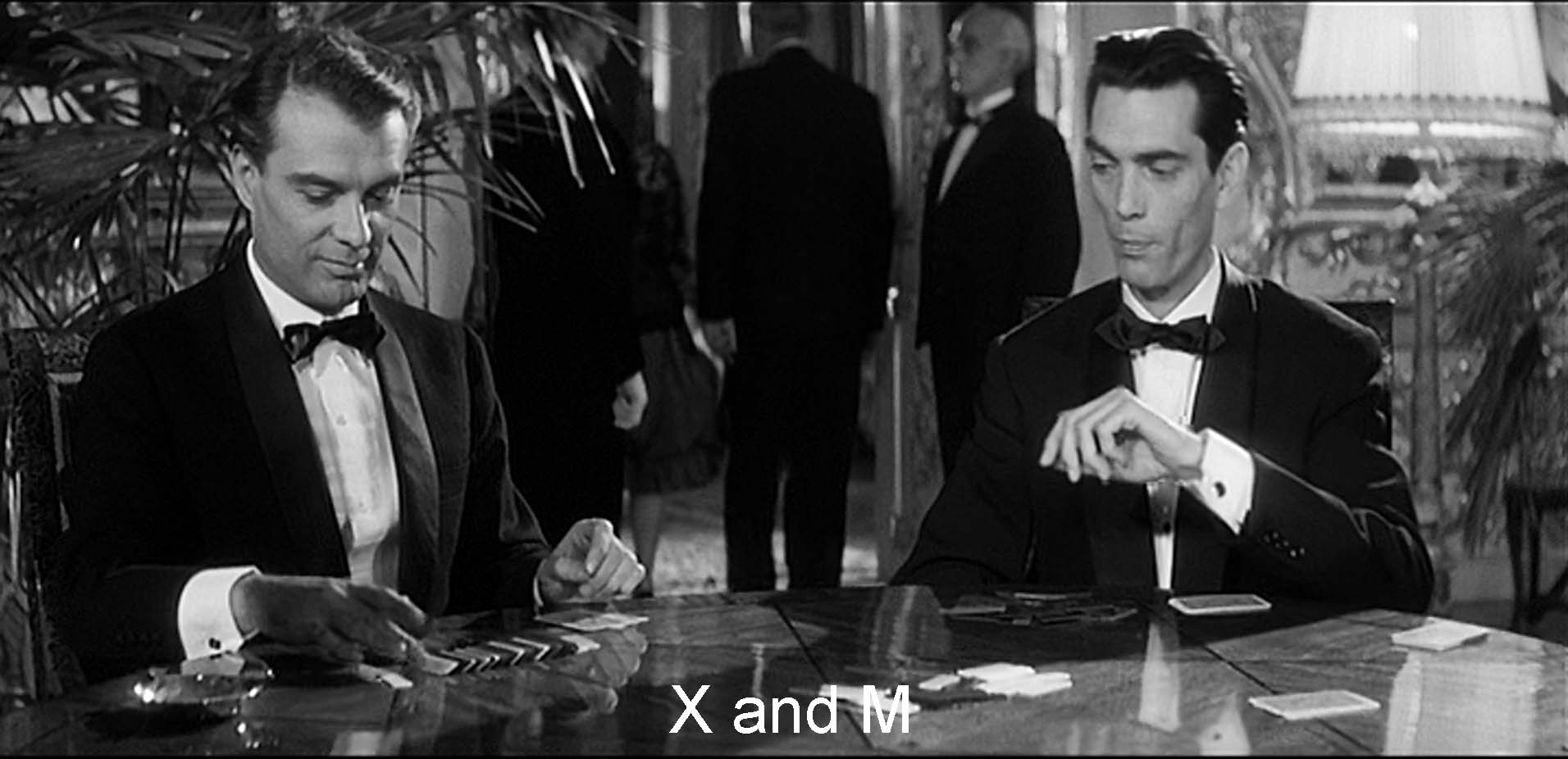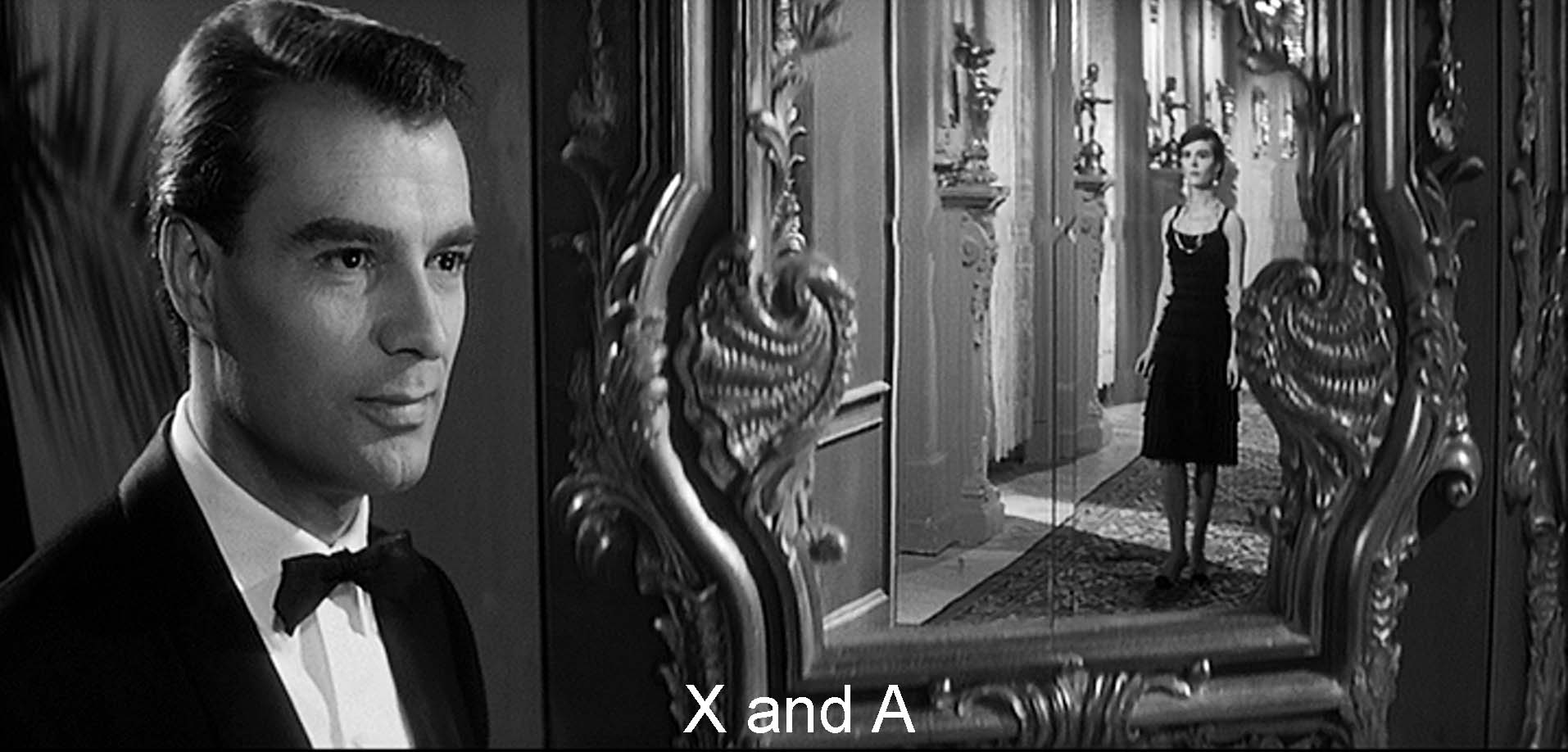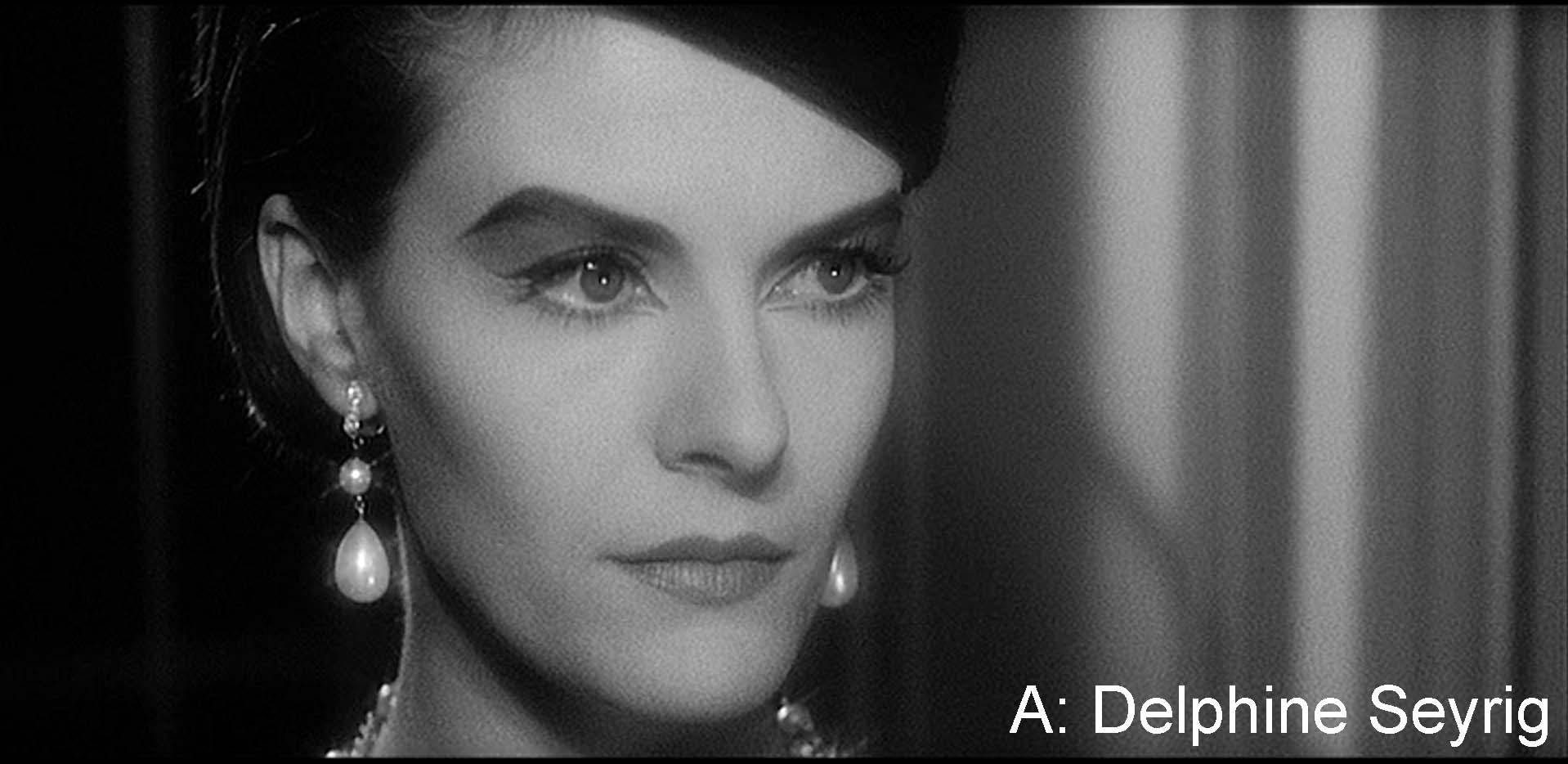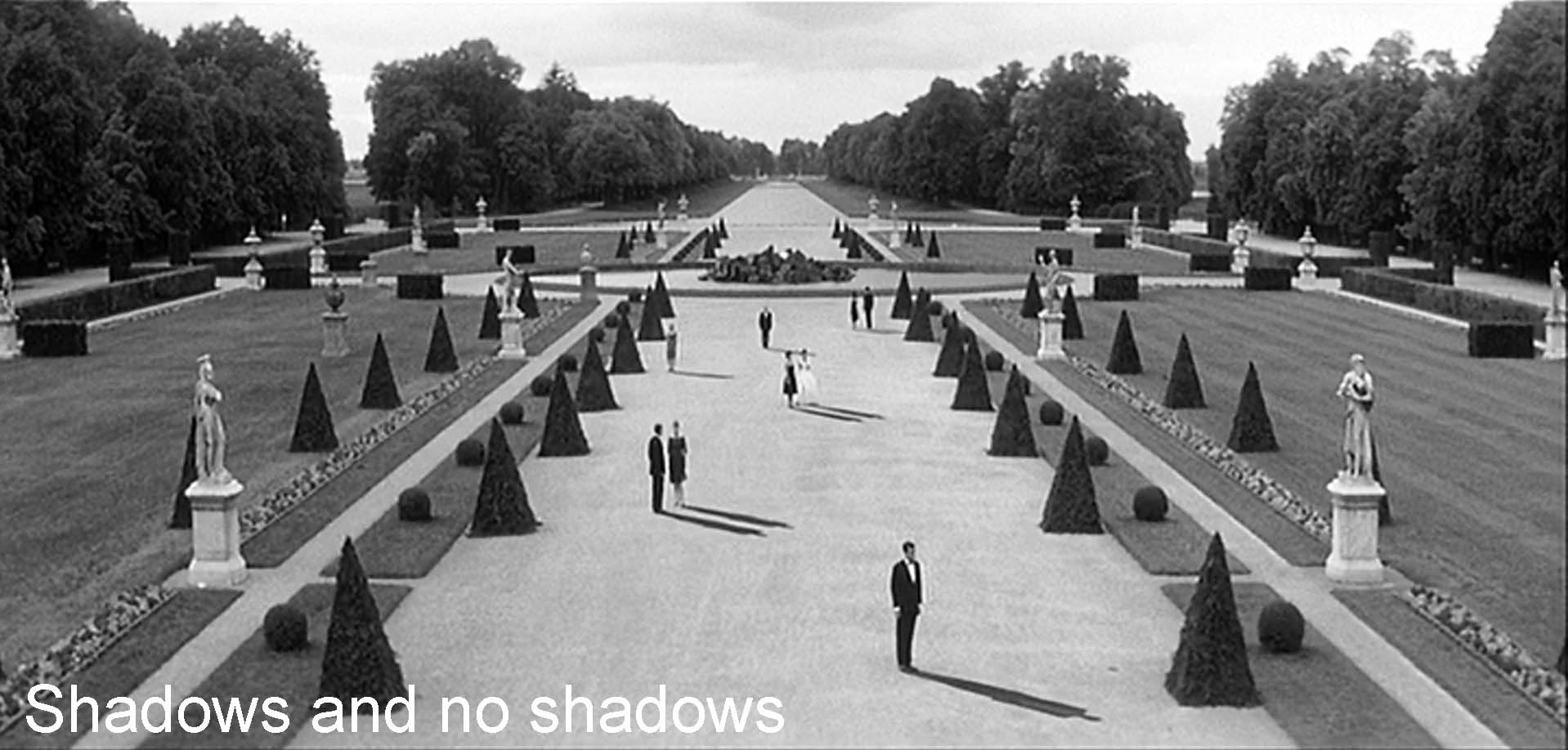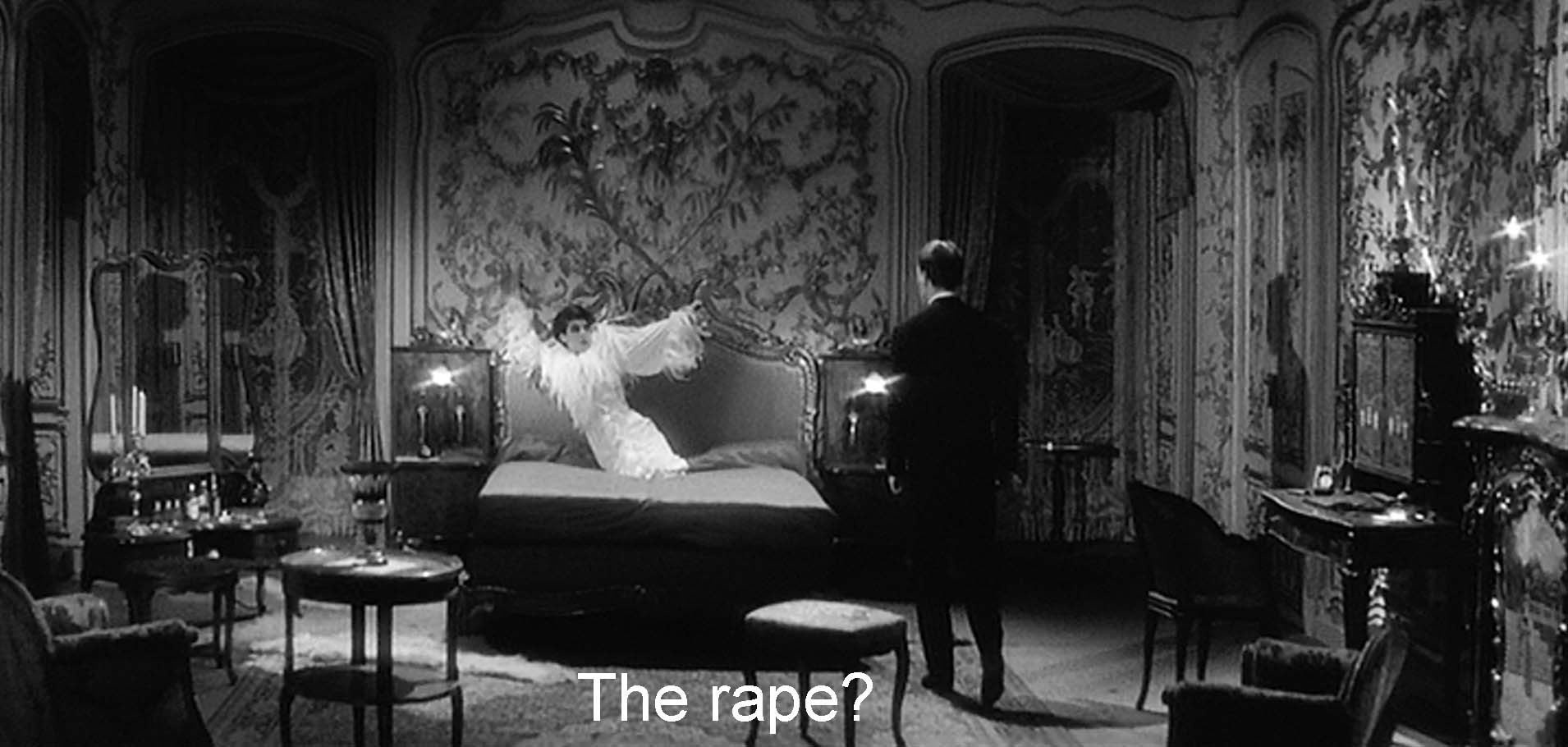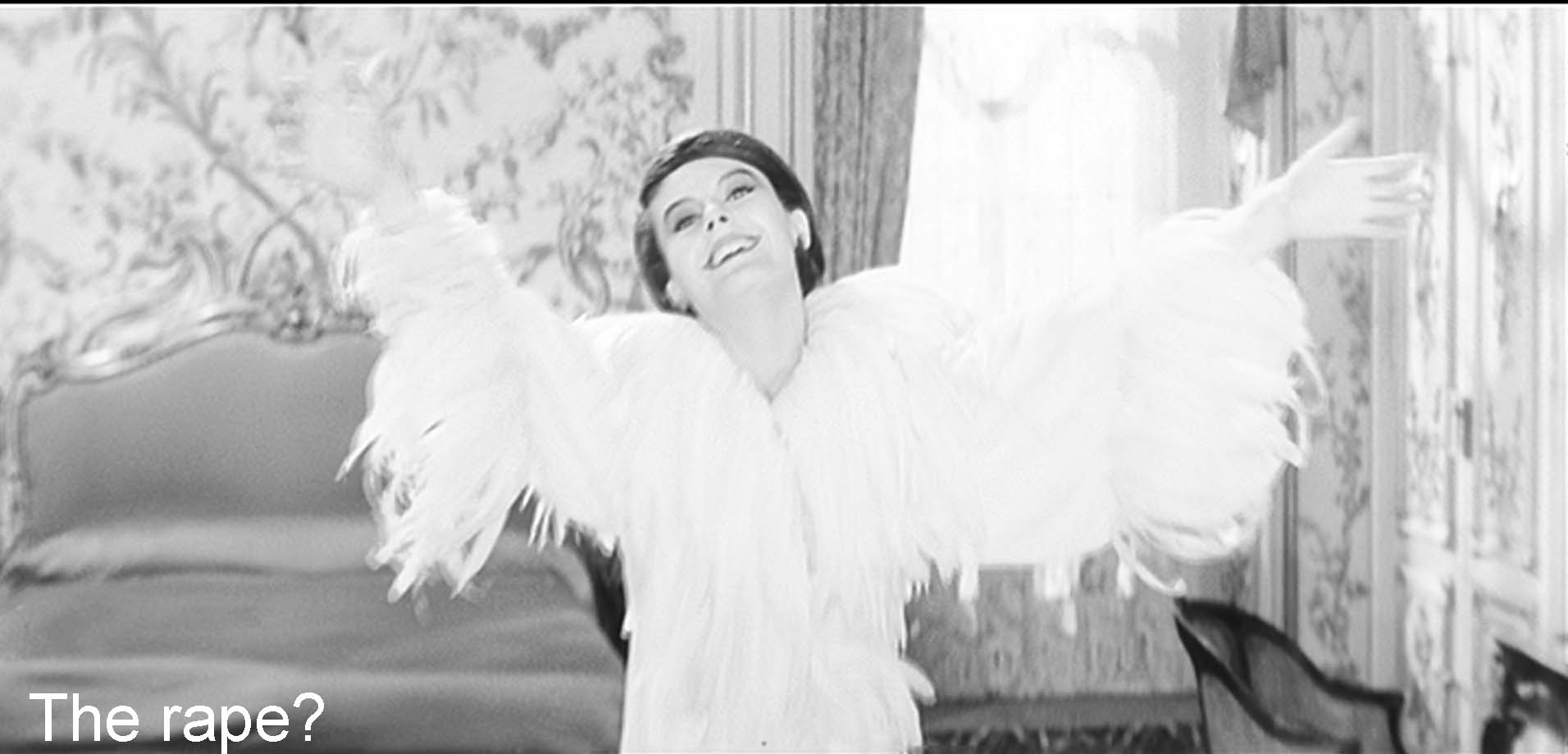Alain Resnais’ and nouveau roman novelist Alain Robbe-Grillet’s L’année dernière à Marienbad first appeared in 1961. It spread consternation and confusion among the reviewing community and viewers today may share the same dismay. The film is nothing but inconsistencies, one after another. There is even a brief view of Hitchcock.
The film takes place in a huge resort hotel made over from a baroque palace. (Actually, Resnais used three different hotels—an inconsistency right there.) It has seemingly innumerable corridors, side rooms, lobbies, windows, mirrors, pictures and diagrams of the resort, and a tailored garden in the French manner. In this hotel are a lot of rich, fashionably dressed guests making cryptic conversation, watching a play, attending a concert, shooting in a shooting gallery, and playing games of cards. They all vousvoyer, addressing one another in the formal “you” as aristocrats do. It is “a place for relaxation. No business was carried out. No plots were hatched. No one discussed any topic that might cause excitement.”
Among these guests are A, the beautiful Delphine Seyrig, rigged out in gowns and peignoirs by Coco Chanel, her hair in an almost boyish bob. Accompanying her is a man M (the cadaverous, expressionless Sacha Pitoëff). Perhaps he is her husband. (M might stand for mari, husband—or for mort, death.) Intruding on them is X (an Italian heartthrob, Giorgio Albertazzi) who narrates the film in voiceover. Using vous like the others, he insists to A that he met her last year in a spa, that they had sex (forced? unforced?), and that she agreed to go away with him, but insisted that he had to wait a year.
Resnais presents this banal plot in a series of inconsistent possibilities. They met at Frederiksbad or was it Baden-Salsa, Karlstadt, or even Marienbad? She was wearing white—or black. He did or did not take a photograph of her. He did or did not enter her bedroom. She did or did not lose the heel of her shoe. They did or did not have sex. She was willing—or unwilling and raped. Filmically, the sets present a labyrinth and the editing gives us jump cuts and sound overlaps. The whole film gives us bafflingly inconsistent possibilities.
A few reviewers have tried to sort out the inconsistencies and decide what “really” happened. Others, cannier, labeled the film a meditation on truth or memory or the past or the nature of reality or psychosis. A joke around Harvard Square at the time: one undergraduate to another, “Have you seen L’année dernière à Marienbad?” The other, slowly, thoughtfully, “I—don’t know.”
I think we need to accept the inconsistencies, not try to explain them. That’s what this film is about: possibilities co-existing with other, inconsistent possibilities. If you see movies in terms of the classic Hollywood style, you will expect it to present a consistent story with the characters having motives leading to actions. You may be annoyed when it doesn’t. When it first came out, Dwight Macdonald objected that “one’s mind and senses are stimulated” but there is no “affective life”: the characters are reduced to A, X, and M. Stanley Kauffmann complained that the film “tries to reproduce actual inner life instead of distilling it,” I think they were both right—in a way.
This is a metafilm, meta- meaning above or beyond. We tend to assume (in our mimetic tradition) that film and theater portray reality. Metatheater takes off from this portrayal-theater and plays against it in the tradition of Pirandello, Becket, Genet, Gelber, Ionesco, Gurney, and just about everybody nowadays. Metafilm does the same, in films like Spike Jonze’s Being John Malkovich (1999), Christopher Nolan’s Memento (2001) or Michel Gondry’s Eternal Sunshine of the Spotless Mind (2004). Back in 1961, people were just getting used to metafilm in such nouvelle vague movies as Alain Resnais’Hiroshima, Mon Amour (1959) or his Muriel (1963).
I believe that we can best understand all metafilmic movies and metatheatrical plays as the quite literal and highly realistic playing-out of a psychological (usually psychoanalytic) proposition about the mind. Thus, the best review of L’année dernière I’ve been able to find (except, of course, for my own review in the Hudson Review, 1962) is Penelope Houston’s in Sight and Sound in 1961. She read it realistically in terms of the relationship between the characters, but she also read it as developing a psychological idea: “L’Année Dernière is a study in persuasion.” “The stranger’s strength is in the sheer power of will: he wants it to be so; it will be so; it is so.”
I read L’année dernière à Marienbad as a series of inconsistent possibilities. At first Resnais presents them as simply there; as actually happening, and then he forecloses them into one final ending. The action of the movie is to end the endless possibilities and land on a fact (at least, a fictional fact represented in a movie). As Houston says, “We are watching a conviction gradually taking shape on the screen.” “There are only a series of possibilities which become actual once they are believed and accepted.” “The meaning of the film is . . . in this process of exploration, this containing of possibilities.”
Some reviewers claimed that the film is saying “reality is an infinite series of possibilities.” But that’s not so, is it? Isn’t reality rather an infinitely decreasing series of possibilities? I believe the Second Law of Thermodynamics said something of the sort. And anyway, this film has nothing to do with reality in any usual sense: the corridors of Nymphenburg are hardly life as she is lived. Nor are the possibilities in L’année dernière very possible, because they conflict.
In life, things are either one way or the other; here, they are both. The people cast shadows, but the bushes don’t; a violin plays, but we hear an organ. The heroine did lose the heel of her shoe. No, she didn’t. She did meet X a year ago, but she didn’t. And so on.
The style is not that of reality at all, but of dreams or the id:
The laws of logic—above all, the law of contradiction—do not hold for processes in the id. Contradictory impulses exist side by side without neutralizing each other or drawing apart; at most they combine in compromise formations . . . There is nothing in the id which can be compared to negation, and we are astonished to find in it an exception to the philosophers’ assertion that space and time are necessary forms of our mental acts. In the id there is nothing corresponding to the idea of time, no recognition of the passage of time. . . . Naturally, the id knows no values, no good and evil, no morality.
—so Freud in the New Introductory Lectures (1932), and so L’année dernière à Marienbad.
The whole point about possibilities in L’année dernière is that they are all there at once, frozen at it were, and this quality comes across in the formal haute couture, of the film, its acting which is not acting at all, but posing in the manner of fashion ads or the old rotogravures—again, competing possibilities actualized. The atmosphere of the “resort-hotel” and its “park,” the formal clothes the guests wear, the recurring performance of a play, the ritualized and prescribed life within the resort—these define a world in which all possibilities (whether known presently or not) have been established at the outset (and will be narrowed down as the film proceeds)
The film opens by exploring the splendiferous baroque tracery of the ceilings and walls. They represent a style in which the decorator has actualized all the possibilities a given line has. We see baroque plasterwork with endless branchings and mirrors with intricate reflections. And shadows, especially the iconic image of people standing in the garden: the people have shadows but the shrubs do not. (Resnais had the people’s shadows painted on the gravel.)
The key image is games and play. The shuffled deck, the dealt dominoes, the formal shooting-match contain at the outset all possible outcomes; nothing wholly unpredictable can happen. In particular, of course, the film uses the so-called “Marienbad game.” Two players set out matches (cards, chips, dominoes, photographs) in four piles: 1, 3, 5, and 7. Playing alternately, each player can take as many matches as he likes from any one pile; the one who must take the last match “loses.” This is, of course, nothing but the old mathematical diversion of Nim. A couple of mathematical friends have been kind enough to explain the theory for me, as it applies to the version in L’année dernière. (You’ll find a much more complex version in the Wikipedia entry for “Nim,” including a computer program that always wins, as M does in the movie.)
The first step is to write (or imagine) the number of matches in each pile in numbers to the base two, arranging those binary numbers in a column for addition; thus, the version in the movie is written:
|
1
11 101 111 224 |
To win the game, let the other player start; then remove matches in such a way that the number of units in each column after your move is either even or zero (but do not, near the end of the game, leave your opponent an even number of piles with one match in each). Because, in the Marienbad version, the starting arrangement is a winning combination, the one who plays second (M, in the film) can always force a win. The one who plays first (M does this once) can force a win if his opponent doesn’t know the system. “He knows all the outcomes in advance,” someone says. Sort of. Tall, he looks down at the other players, dominating them.
Resnais and Robbe-Grillet are using the properties of this game much as Bergman used the two-dimensional properties of chess in The Seventh Seal. The film pretends that Nim is a true game in which either player could win. Actually, once the piles are laid out, the game is as determined as tic-tac-toe—a perfect symbol for possibilities which begin as many but converge to one foregone conclusion. A leaves with X.
I suspect that the form of the film, the logic of that quite incredible mélange of flashbacks, “objectivized hypotheses,” and so on, derives from the series of choices involved in Nim: each match offers one of two choices, to take it or not to take it, limited by the rule that you can take only from one pile at a time, just as one possible event depends on the possibility of the sequence in which it is a part. Thus, 1) A and X had or had not met at Marienbad last year. 2) She agreed to go away with him; she insisted on waiting a year. 3) He did or did not take a photograph of her. 4) They did or did not have a daylight meeting in the park at which she lost the heel of her shoe. 5) X did or did not take her by force in her bedroom. 6) They did or did not have a night meeting in the park at which X, when M confronted the lovers, leaned on a faulty balustrade and fell. 7) M did or did not shoot A at an assignation in her bedroom. All these inconsistent possibilities (and some others) co-exist in the film, discoverable by the different clothes the characters wear for the different possible sequences. And the movement of the film is to reduce or foreclose these possibilities. Just as X’s games of Nim with M (le mari peut-être) inevitably end with X’s taking the last match, so the film ends by X’s leaving the hotel with the lady. As they leave, the screen goes to black, and the voice of X says:
The park of this hotel was a kind of garden la francaise without any trees or flowers, without any foliage. . . . Gravel, stone, marble and straight lines marked out rigid spaces, areas without mystery. At first glance, it seemed impossible to lose your way . . . At first glance . . . Down straight paths, between statues with frozen gestures and granite slabs, where even now, you were losing your way forever, in the stillness of the night, alone with me.
The film breaks decisively with that closed id-world of inconsistent possibilities. A and X have left the world of the unconscious (as described by Freud), where there is no negative, no sense of time, for a world where one can lose one’s way. They have become free.
The film thus portrays a proposition about mental life. It is, in Robbe-Grillet’s terms, “an attempt to construct a purely mental time and space—those of dreams, perhaps, or of memory, those of any affective life-without worrying too much about the traditional relations of cause and effect, or about an absolute time sequence in the narrative.” “He offers her the impossible, what seems most impossible in this labyrinth where time apparently abolished: be offers her a past, a future and freedom.” Indeed, in therapeutic terms, by accepting a past one has denied (the repressed), one does achieve this freedom. By accepting time, specifically the fact that time forecloses possibilities and eliminates freedom, paradoxically, one achieves freedom. One escapes the stifling determinism of an unconscious that you don’t understand. A can lose her way.
This explication is not inconsistent with some ingenuities this film prompted, for example, that A, M, and X represent the oedipal triangle in a recurring dream; or that A is mad, X a psychiatrist, and M her madness; that X is Death, A the Maiden, M a frozen immortality; that X is Prince Charming, A the Sleeping Beauty, and M the Wicked Witch (or Warlock). The play mentioned in the film. Rosmer, probably refers then, not to Ibsen’s Rosmersholm, but to a folktale about Rosmer Havmand. He is a troll or merman, handsome in form, who lures a maiden away from her home to his other world. So here, X will lure A away from M and her strange but, to her, familiar world.
All these are aspects or possibilities of what seems to me the informing idea behind the film: Acceptance of the past (the repressed or a time-sense) represents release from the inexorable drives (the imprisoning resort-hotel) of the id (or the dopaminergic system) toward the world of decision, the ego (or cognition). The film is a portrayal of Freud’s description of the id, not the id itself—that would be impossible. This film resembles metatheater, allegory, or such ancient genres as the morality play, because it portrays mental principles, not mental life.
Reading the film along these lines may (or may not) ease that baffled feeling. It certainly will not answer the judgment that the film is cold because the film certainly is cold. Is that necessarily bad? We admire metatheatrical playwrights like Beckett and Ionesco. They play against our emotional expectations as much as they are playing against our expectation of realism. They ask that we respond intellectually and with laughter. Do they ask for more than the merest smudge of emotions?
Repeatedly, Robbe-Grillet seems to suggest in his account of the collaboration that he wanted a film addressed exclusively to the senses. I would add that the film is directed to the intellect as well, but one thing is clear: this film is aimed only indirectly, if at all, at the emotions. What little feeling I have when I see this film is curiously isolated, scarcely above the level of sensuous response. Just as the theme I see is the separation of ego from id, so my emotional response is not at all tied in to the intellectual response. Is that bad? Metatheater and metafilm (which, I suppose, constitute a metagenre) define themselves in terms of this special sensuous-intellectual response they call for. Is such a demand bad? Not to me—and I will stick out my cerebrum and call L’année dernière à Marienbad a metamasterpiece.
